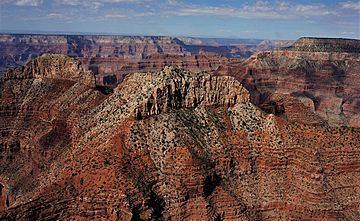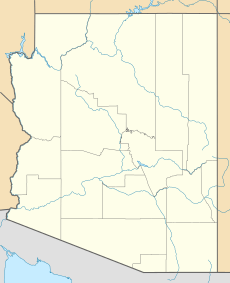Confucius Temple (Grand Canyon) facts for kids
Quick facts for kids Confucius Temple |
|
|---|---|
| Twin Butte | |

East aspect, aerial view
|
|
| Highest point | |
| Elevation | 7,081 ft (2,158 m) |
| Prominence | 935 ft (285 m) |
| Isolation | 2.64 mi (4.25 km) |
| Parent peak | Dragon Head (7,765 ft) |
| Geography | |
| Location | Grand Canyon National Park Coconino County, Arizona, US |
| Parent range | Kaibab Plateau Colorado Plateau |
| Topo map | USGS Shiva Temple |
| Type of rock | limestone, sandstone, mudstone |
Confucius Temple is a tall mountain peak in the amazing Grand Canyon in Arizona, USA. It stands 7,081 feet (about 2,158 meters) high. This special peak is located in Grand Canyon National Park, a famous place known for its incredible views. It's named after a very old and wise Chinese philosopher named Confucius.
Confucius Temple is about 1.5 miles southeast of Point Sublime. It rises over 3,200 feet (1,130 meters) above an area called Hindu Amphitheater.
What's in a Name?
This mountain is named after Confucius (551–479 BC). He was a very important Chinese philosopher. Clarence Dutton started the tradition of naming places in the Grand Canyon after gods and famous thinkers.
Confucius Temple is one of two peaks called the "Twin Buttes" in the Grand Canyon. The other peak is Mencius Temple (7,001 ft). It is named after Mencius, who was another famous Chinese thinker. Many people consider Mencius the second most famous sage, right after Confucius.
The name "Confucius Temple" was officially chosen in 1906. This was done by the United States Board on Geographic Names. The weather around Confucius Temple is usually a cold semi-arid climate. This means it's often dry and can be quite cold.
How the Mountain Was Formed
Confucius Temple is made up of many layers of different rocks. These layers were formed over millions of years.
Rock Layers
The very top of Confucius Temple is made of Kaibab Limestone. This rock formed during the Permian period. Below that is the Toroweap Formation. Then comes the cream-colored Coconino Sandstone. This sandstone is made from ancient sand dunes. These dunes were deposited about 265 million years ago.
Under the Coconino Sandstone, you'll find reddish Hermit Formation. Below that is the Supai Group. Even further down are layers of Redwall Limestone. This rock is very noticeable. Then there's the Tonto Group from the Cambrian period. Finally, at the Colorado River level, you can see very old granite rocks. These are called the Vishnu Basement Rocks.
Water Flow
Rainwater and melted snow from Confucius Temple flow in two main directions. Some water drains west into Tuna Creek. Other water flows east into Crystal Creek. Both of these creeks eventually join the Colorado River.



